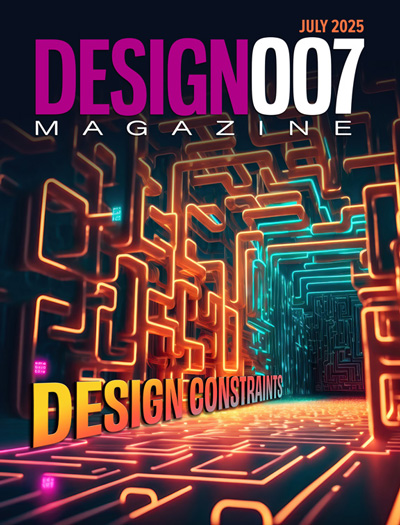-

- News
- Books
Featured Books
- design007 Magazine
Latest Issues
Current Issue
Signal Integrity
If you don’t have signal integrity problems now, you will eventually. This month, our expert contributors share a variety of SI techniques that can help designers avoid ground bounce, crosstalk, parasitic issues, and much more.

Proper Floor Planning
Floor planning decisions can make or break performance, manufacturability, and timelines. This month’s contributors weigh in with their best practices for proper floor planning and specific strategies to get it right.

Showing Some Constraint
A strong design constraint strategy carefully balances a wide range of electrical and manufacturing trade-offs. This month, we explore the key requirements, common challenges, and best practices behind building an effective constraint strategy.
- Articles
- Columns
- Links
- Media kit
||| MENU - design007 Magazine
PCB Layout Rules of Thumb for Consideration
November 25, 2024 | Patrick Davis, Cadence Design SystemsEstimated reading time: 1 minute
Just because a “rule of thumb” is usually based on experience instead of precise facts doesn’t negate its value. For instance, when I told my kids that a good rule of thumb was not to back-talk to their mother, they discovered very quickly how accurate my advice was once they crossed that line. There are a lot of rules of thumb that we rely on daily, including those that apply to PCB design.
While many aspects of PCB layout are governed by procedures, standards, and workflows, there is still much that belongs only to tribal knowledge. Unless this knowledge is collected, documented, and incorporated into a design database, it will only exist in the information that gets passed from one designer to the next. Let’s take a look at some of the more common PCB layout rules of thumb and see how they apply to the boards we are currently laying out.
Start with a Plan
Something that you probably won’t ever find printed in a company procedure or a PCB design tutorial is the importance of having a plan before you start. Many layout designers have been known to plunge right into a new design, without first considering all the ramifications of what they are doing. This can lead to routing frustrations and eventual changes to the placement to complete the design correctly. To avoid problems like these, give some thought to what you are trying to accomplish before you start placing parts.
To read this entire article, which appeared in the November 2024 issue of Design007 Magazine, click here.
Testimonial
"Advertising in PCB007 Magazine has been a great way to showcase our bare board testers to the right audience. The I-Connect007 team makes the process smooth and professional. We’re proud to be featured in such a trusted publication."
Klaus Koziol - atgSuggested Items
ICAPE Group Unveils Exclusive Report on Sustainability in Electronics Manufacturing
09/15/2025 | ICAPE GroupICAPE Group, a global leader in printed circuit boards (PCBs) and custom electronics manufacturing, today announces the launch of its 2025 Industry Outlook & Innovation Report: Sustainability in Electronics Manufacturing. This exclusive report is accompanied by fresh insights from a dedicated Statista survey of 100 electronics manufacturing professionals, commissioned by ICAPE Group.
Zhen Ding Drives AI-Powered Digital Transformation
09/12/2025 | Zhen DingDriven by the surging demand for computing power fueled by AI, the semiconductor and PCB industries are forging closer integration, expanding their ecosystems, and pursuing shared growth. PCB has already become another NT$ trillion-dollar industry in Taiwan, growing in tandem with the semiconductor sector.
I-Connect007 Editor’s Choice: Five Must-Reads for the Week
09/12/2025 | Marcy LaRont, I-Connect007We may be post-Labor Day, but it is still hot-hot-hot here in the great state of Arizona—much like our news cycles, which have continued to snap, crackle, and pop with eye-raising headlines over this past week. In broader global tech news this week, AI and tariff-type restrictions continues to dominate with NVIDIA raising its voice against U.S. lawmakers pushing chip restrictions, ASML investing in a Dutch AI start-up company to the tune of $1.5 billion, and the UAE joining the ranks of the U.S. and China in embracing “open source” with their technology in hopes of accelerating their AI position.
Zhen Ding Expands PCB into Semiconductors at SEMICON Taiwan 2025; Advantech Drives AI Smart Parks
09/12/2025 | Zhen DingZhen Ding Technology Holding Co., Ltd., a global leader in the PCB industry, returned to exhibit at SEMICON Taiwan 2025. Positioning itself as an industry pioneer in "PCB expanding into semiconductors," the company showcased its latest strategic layout
Direct Imaging System Market Size to Hit $4.30B by 2032, Driven by Increasing Demand for High-Precision PCB Manufacturing
09/11/2025 | Globe NewswireAccording to the SNS Insider, “The Direct Imaging System Market size was valued at $2.21 Billion in 2024 and is projected to reach $4.30 Billion by 2032, growing at a CAGR of 8.68% during 2025-2032.”


